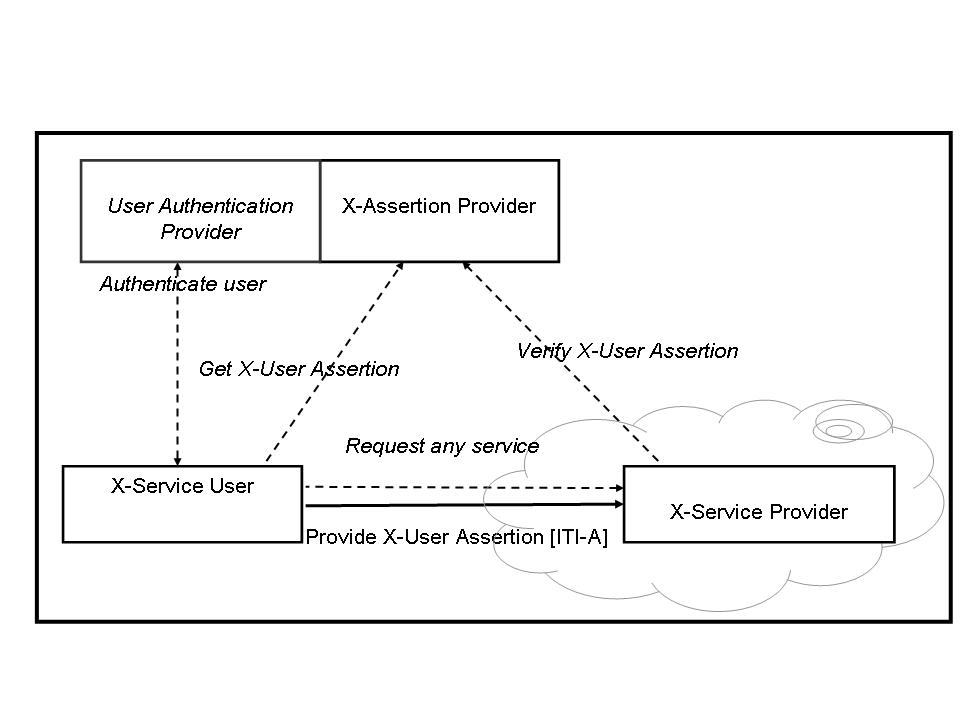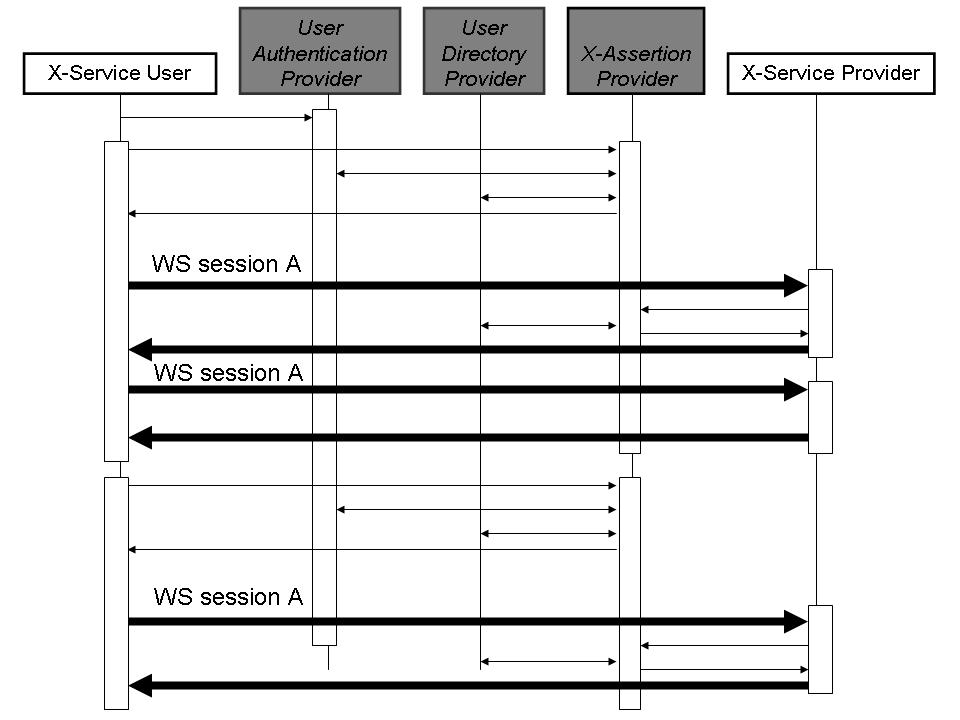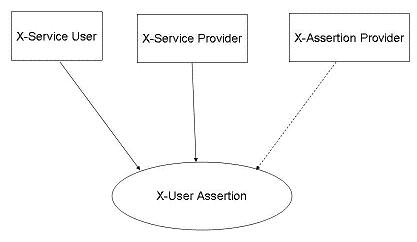Cross-Enterprise User Assertion (XUA) Profile
Introduction
This is a draft of the Cross-Enterprise User Assertion Profile (XUA) supplement to the ITI Technical Framework. This draft is a work in progress, not the official supplement or profile.
Profile Abstract
The Cross-Enterprise User Assertion Profile (XUA) defines a set of trustable claims about an authenticated principal (user, application, system...) using a transactions that may cross enterprise boundaries. To provide accountability in these cross enterprise transactions there is a need to identify the requesting user in a way that the receiver can make access decisions and proper audit entries. The XUA Profile will support enterprises that have chosen to have their own user directory with their own unique method of authenticating the users, and others that may have chosen to use a third party.
Issue Log
See Cross-Enterprise User Assertion - Discussion
Glossary
Add the following items to the Glossary
- XUA
- Cross-Enterprise User Assertion (Formerly Cross-Enterprise User Authentication)
- User Assertion
- blah blah
- Principal
- An end user, an application, a machine, or any other type of entity that may act as a requester. A principal is typically represented with a digital identity and may have multiple valid digital identities -- Source WS-Federation
Volume I
Add the following bullet to the list of profiles in section 1.7
- Cross-Enterprise User Assertion - provides the user identity in transactions that cross enterprise boundaries. Enterprises may choose to have their own user directory and their own unique method of authenticating the users, they may even choose to use a third party. To provide accountability in these cross enterprise transactions there is a need to identify the requesting user in a way that the receiver can make access decisions and proper audit entries.
Dependencies
Add the following row(s) to the list of dependencies in section 2.1
| Integration Profile | Dependency | Dependency Type | Purpose |
|---|---|---|---|
| Cross-Enterprise User Assertion | None | None |
Add the following section to the section 2.2
2.2.n Cross-Enterprise User Assertion (XUA)
Cross-Enterprise User Assertion (XUA) provides the user identity in transactions that cross enterprise boundaries. Enterprises may choose to have their own user directory and their own unique method of authenticating the users, they may even choose to use a third party. To provide accountability in these cross enterprise transactions there is a need to identify the requesting user in a way that the receiver can make access decisions and proper audit entries.
Add the following section to Vol 1
Cross-Enterprise User Assertion (XUA) Integration Profile
The Cross-Enterprise User Assertion Profile (XUA) defines a set of trustable claims about an authenticated principal (user, application, system...) using a transactions that may cross enterprise boundaries. To provide accountability in these cross enterprise transactions there is a need to identify the requesting user in a way that the receiver can make access decisions and proper audit entries. The XUA Profile will support enterprises that have chosen to have their own user directory with their own unique method of authenticating the users, and others that may have chosen to use a third party.
There are transactions defined by IHE that cross enterprise boundaries. The existing IHE mechanisms to provide an authenticated user identity (EUA) will not function in cross-enterprise transactions. Further in a cross-enterprise environment it is more likely that the transactions will be going between two enterprises that maintain their own independent user directories (PWP). This problem is the same focus of the Identity Federation standards. This topic has received much attention by the security and the platforms industry. Identity Federation allows for centralized user directory, but also supports the more powerful federation of user directories. Identity Federation supports many methods of user authentication (password, biometrics, smartcard) and can include details about the method(s) used.
The solution proposed is to leverage Web-Services Security, SAML 2.0 Token Profile and the various profiles from W3C, OASIS, and WS-I. In this way we will be able to take advantage of the vast experience of the communities outside of healthcare standards. This profile will be leveraging the experience of a few programs around the globe that have started work with SAML in healthcare. Most of these projects are applying SAML to XDS as we expect to be doing in the first year.
Discussion about the creation of this profile can be found at Cross-Enterprise User Assertion - Discussion
Use Cases
This profile will likely take two years to fully fill out. In the first year we will be focusing only on XDS Consumer Actor: XDS Registry Stored Query and XDS Web Services Retrieve Document *** transactions. The motivator for this is that these are the most exposed transactions that IHE has defined; their use is expected to be from a wide variety of consuming applications and enterprises; and they utilize modern Web-Services standards.
A worst case for the XUA profile is where the use-cases involve at least two different trust domains that are operating under different technology, procedures, role-models, etc. They are cooperating in the XDS Affinity domain under an overarching trust relationship policy that indicates that these differences can be rationalized. The XDS transactions are transferring access control from one entity to another. For example, they will be using XDS to exchange data between a single doctor practice, the VA, and Mass. General. It is not likely that they will all agree to the same access control model. It is not necessary to have access control details agreed to, but it is reasonable that at the policy level they will agree. This illustrates an important fact that the XUA is useful for security audit logging, but is to a lesser extent useful for access controls.
- Country that provisions users into a single assigning authority domain (e.g., Germany) and handles all user authentication requests
- Support for centralized user directories
- Region that knits together many competing hospitals and clinics where each hospital/clinic manages their own users.
- Support for distributed user directories
- Patient that wishes to use their ISP as their authentication authority uses a PHR like application to access their own information in XDS.
- Support for non-healthcare specific user directories
- Hospital issues identity badges with picture and name printed, RFID for building access, and smart-card for strong authentication
- Support for claims about the method used to authenticate the user (e.g. strong authentication methods such as smart-cards)
- Small clinic in a rural setting supports a dozen users.
- Support for small scale systems (e.g., user at a kiosk, system using simple passwords)
- General practice doctor retrieving results of a test performed by an outpatient clinic, where the outpatient clinic wants to have an audit trail specific to the user requesting.
- Support for the service provider to get a user identity for audit log purposes
- System, based on a scheduled procedure, pre-fetches the available documents so that it can determine a relevant few documents to offer to the doctor when the patient arrives.
- Support for identifying the user as the system for tasks that are not initiated by a human user
- Access of a document by an individual that can’t be identified because the Assertion Provider is not accessible
- Support for infrastructural failure **** Not clear if this is in scope, or is a performance criteria for implementor ****
- User using Registry or Repository where the service provider wants to be assured that the user has been authenticated to a specific assurance level. This is not a case of not trusting the system, but recognition that the requesting supports different levels of authentication. For example the system supports a proximity card as a form of authentication, as well as Smart-Card with PIN. This is not a replacement for ATNA access controls which give distributed access controls.
- User Identity with level of assurance of that identity is needed.
- Specialized XDS for Emergency Dataset. In this case the transfer of information to the XDS Consumer is not critical to fully control, and thus the administration is willing to accept requests from any system as long as they can provide a user-assertion from a trusted source. This trusted-source may be a specialized IDP for First Responders. (See RSA Pilot)
- In this case only a user identity with proper linkage to a trusted IDP is needed. No specific attributes are needed.
- User using a Cross-Community-Gateway needs to provide a user assertion that can be utilized by the Cross-Community-Gateway.
- Where the Cross-Community-Gateway needs to act-on-behalf of the requester, this will require that the Assertions can be re-purposed (delegation) for the next Bridge or Reg
- User acting in an identified clinical role accesses the Registry where the Registry wants to know the user identity and the role they are acting in to record the identity and role in the audit log.
- Support inclusion of functional roles as named vocabulary
- The Role of the user as the data subject (patient)
- Service provider wants to enforce some form of access controls based on the user identity and/or functional role.
- Support for the service provider to augment access controls based on some non-specified rules that are applied to the user and/or functional role
- Doctor in an emergency situation request to retrieve documents that would under normal conditions would not be accessible because the privacy consent (BPPC) has restricted access
- Support for Emergency override (aka Break-Glass) *** Not clear what affect this has on XUA ***
Solution
The vast majority of the use-case (items 1-12) needs are captured in the SAML 2.0 Assertion. This is a mature standard produced by OASIS. For our first year we have two transactions that utilize Web-Services, and thus we will specify that when a Cross-Enterprise User Assertion is needed that these Web-Services transactions will additionally use the Web-Services Security header with a SAML 2.0 Assertion. As with any IHE profile, the applications are not forbidden to use other methods of providing the user identity.
This profile will show how to reference a SAML 2.0 Assertion in an ATNA Audit Message.
The method of authenticating the user and the method that the XDS-Consumer uses to get the SAML 2.0 Assertion is outside the scope of this profile. There is no identified interoperability problem in this transaction as the space is well specified and products certified by Liberty Alliance. One method of authenticating the user is defined in the Enterprise User Authentication Profile. When EUA is used to authenticate the user, this profile will show how to obtain the SAML 2.0 Assertion. A specialization of this interaction is when the user is using a web browser and the XDS-Consumer actor is implemented by web-middleware. In this case the SAML Browser SSO Profile may be utilized by the middleware to obtain the SAML 2.0 Assertion. All other authentication types are left undefined, but allowed.
There are user attributes that appear to be needed in the use-cases: Doctor, Patient, Guardian, Emergency-Access. The SAML 2.0 Assertion can contain attributes about the user. At this time it is not clear what standards to use to identify these attributes and their values, so this is left to specific implementations that have defined a local vocabulary or vocabulary translation.
The method used by the XDS-Consumer to determine the contents of the SAML 2.0 Assertion is outside the scope of this profile. This profile will show in an informative way how to utilize SAML Metadata, and WS-Policy.
It is expected that extending this solution to HL7 and DICOM will be supported in the future.
Actors/Transaction
| Actor | Transaction | Optionality | Section |
|---|---|---|---|
| X-Service User | Provide X-User Assertion | R | ITI-A |
| X-Service Provider | Provide X-User Assertion | R | ITI-A |
Options
| Actor | Option | Section |
|---|---|---|
| X-Service User | None | |
| X-Service Provider | None |
Grouping
Process Flow
In the above flow we are showing more actors than are specified in this profile. The User Authentication Provider, User Directory Provider and X-Assertion Provider are not profiled here, but rather are shown to give a context to the XUA transactions.
Actor Definitions
Add the following Actor Summary Definitions in Appendix A
- X-Assertion Provider
- This is a SAML Identity Provider (IDP), and is not further specified by IHE.
- X-Service User
- This is the system making a web-services request. In the first year this is the XDS-Document Consumer Actor.
- X-Service Provider
- This is the system providing the web-service. In the first year this is the XDS-Document Registry and XDS-Document Repository Actors.
Transaction Definitions
Add the following Transaction Summary Definitions in Appendix B
- Provide X-User Assertion
- This transaction provides a trustable user assertion from the service user to the service provider
Volume II
Add the following Transaction to Volume II
Provide X-User Assertion
This section corresponds to Transaction ITI-XXX of the IHE IT Infrastructure Technical Framework.
Scope
Transaction ITI-XXX is used by the X-Service User to pass a trustable identity assertion to the X-Service Provider. The X-Service User and X-Service Provider use the X-Identity Provider as the trusted third party issuer of the trustable identity assertion.
Use Case Roles
- Actor
- X-Service User
- Role
- User of a transaction that requires a Cross-Enterprise User Assertion
- Actor
- X-Service Provider
- Role
- Service provider on a transaction that requires a Cross-Enterprise User Assertion
- Actor
- X-Assertion Provider
- Role
- Source of Cross-Enterprise User Assertions
Referenced Standards
Normative -- required to use this profile
- OASIS http://www.oasis-open.org/committees/security/.
- SAMLCore SAML V2.0 Core standard
- WS-Trust OASIS Committee Draft, "WS-Trust 1.3", September 2006
- WS-SecureConversation OASIS Committee Draft, “WS-SecureConversation 1.3", September 2006
- WSS10 OASIS Standard, "OASIS Web Services Security: SOAP Message Security 1.0 (WS-Security 2004)", March 2004.
- WSS11 OASIS Standard, "OASIS Web Services Security: SOAP Message Security 1.1 (WS-Security 2004)", February 2006.
- WSS:SAMLTokenProfile1.0 OASIS Standard, “Web Services Security: SAML Token Profile”, December 2004
- WSS:SAMLTokenProfile1.1 OASIS Standard, “Web Services Security: SAML Token Profile 1.1”, February 2006
Informative -- assist with understanding or implementing this profile
- IHE Profiles
- Personnel White Pages Profile
- Enterprise User Authentication Profile
- Basic Patient Privacy Consents Profile
- OASIS-OPEN
- SAML V2.0 Standards http://www.oasis-open.org/committees/security/.
- SAMLTechOvw SAML V2.0 Technical Overview (a work in progress currently at revision 10)
- SAML Tutorial presentation by Eve Maler of Sun Microsystems
- SAML Metadata Version 2.0
- SAML V2.0 Standards http://www.oasis-open.org/committees/security/.
- WS-I
- WS-I Conformance Claim
- WS-I Basic Security Profile Version 1.1 (Doesn't use SAML 2.0)
- WS-I Basic Profile Version 1.2 (Doesn't use SOAP 1.2)
- W3C
- ISO
- ISO/TS 21091 Health informatics — Directory services for security, communications and identification of professionals and patients
- ISO 17090 Health informatics - Digital Certificates in Healthcare
- ISO/DTS 21298 Functional and Structural Roles from (work item in committee)
- CEN
- CEN 13606-4 (makes normative ISO 21298 role vocabulary?)


